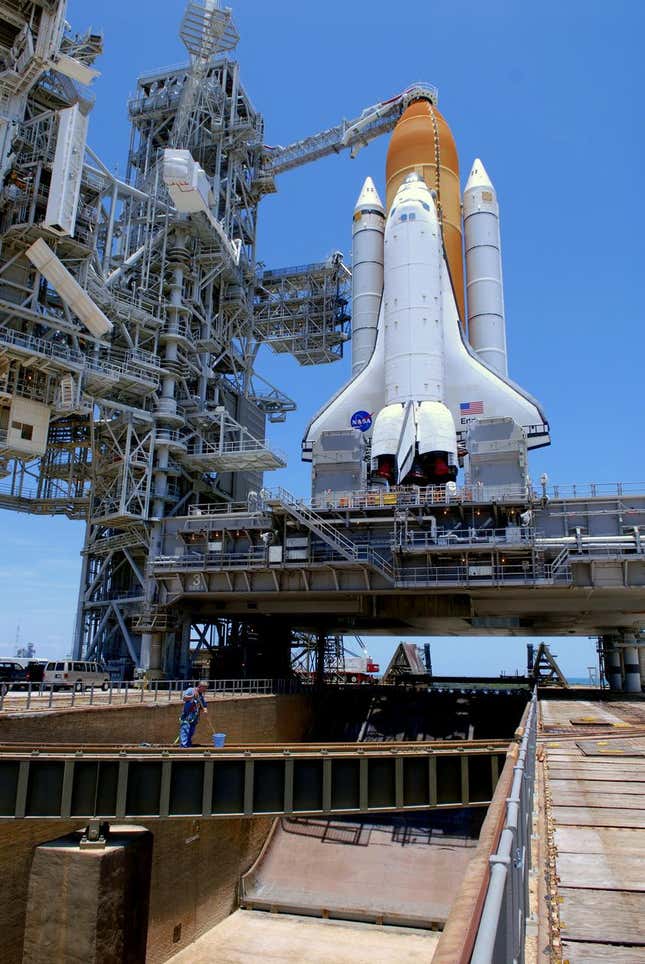The multi-year bureaucratic conflict over the environmental impression of the world’s largest rocket thought-about every thing from endangered birds and historic monuments to exhaust and development noise, however the Federal Aviation Administration (FAA) didn’t anticipate one factor: mud.
As SpaceX’s Starship rocket took flight final week in Texas, greater than two dozen highly effective rocket engines fired directly, pushing the large car into area—and blasting away on the launch gantry and the bottom beneath it with greater than 6,000 metric tons of pressure.
All that vitality led ultra-strong concrete on the base of the launch construction to dissolve, hurling chunks of rubble into the ocean and pelting the location the place journalists set up remote cameras to seize the occasion, even punching by a automotive parked there. These areas are stored clear of individuals for security causes, however the fusillade was nonetheless uncommon in contrast to what’s seen at common launches at Cape Canaveral and Vandenberg Air Pressure base.
69% off
Microsoft Home windows Professional 11
Save 69% On Downloadable Home windows Professional 11, The Newest Downloadable Microsoft Home windows OS
Designed to make hybrid and distant work extra environment friendly and seamless – and solely simply $50
The mud thrown up by the rocket’s engines was extra broadly felt: A thick layer of sand descended on the encircling communities, notably the close by metropolis of Port Isabel. Whereas the mud isn’t identified to be contaminated with any chemical substances, respiration particulate matter basically is hazardous to well being. Final yr, when evaluating the air high quality dangers of a Starship launch, the FAA concluded that it was “not anticipated to end in important impacts to air high quality.”
Requested in regards to the mud, the FAA didn’t instantly tackle the query.
“The FAA is offering oversight to make sure SpaceX complies with its FAA-approved mishap investigation plan and different regulatory necessities,” a spokesperson instructed Quartz. “The FAA will overview, and should approve, the ultimate report earlier than the mishap investigation could be closed.”
Why didn’t SpaceX plan for the huge rocket’s exhaust?
There’s an apparent motive why a lot particles was thrown up (and the launch pad was so broken): SpaceX didn’t construct a flame diversion system or pump in water to soak up warmth and sound vitality. Usually, rocket launch websites have giant concrete trenches that redirect vitality away from the pad and the car, whereas hundreds of gallons of water deluge the world. Right here’s an image of the Area Shuttle sitting above its flame trench in 2009:

It’s not clear why SpaceX didn’t use this type of infrastructure, which is a part of the launch setup for its Falcon rockets. One principle, superior by Eric Roesch, an knowledgeable in environmental impression analyses, is that getting approval to construct it from the US Military Corps of Engineers would require months or years that SpaceX didn’t wish to spend. SpaceX’s utility for such a allow from the US Military Corps of Engineers was withdrawn in 2022 after it declined to think about alternate websites for Starship, like its launch services at Cape Canaveral.
Elon Musk, SpaceX’s CEO, said on Twitter that the corporate had begun constructing a “huge water-cooled, metal plate to go underneath the launch mount” three months in the past. Nonetheless, Musk mentioned the plate wasn’t prepared in time, and engineers went forward with the launch pondering that the high-strength concrete beneath the rocket might stand up to the pressure. That evaluation was apparently primarily based on a check when the rocket was fired at half its thrust capability.
When will Starship launch once more?
Past stopping environmental contamination, Musk and firm have good motive to resolve this downside: It’s attainable that particles thrown up by the rocket contributed to the failure of a number of Starship engines and, in flip, the failure of the car to make it into area. Remaining phrase on any hyperlinks between destruction on the website and destruction in flight will wait on an intensive engineering evaluation.
Musk mentioned that the launch website may be able to go in a single to 2 months, however that’s probably an optimistic estimate. In addition to determining what went mistaken with the rocket itself, the corporate might want to restore its launch infrastructure and win the approval of the FAA once more.


